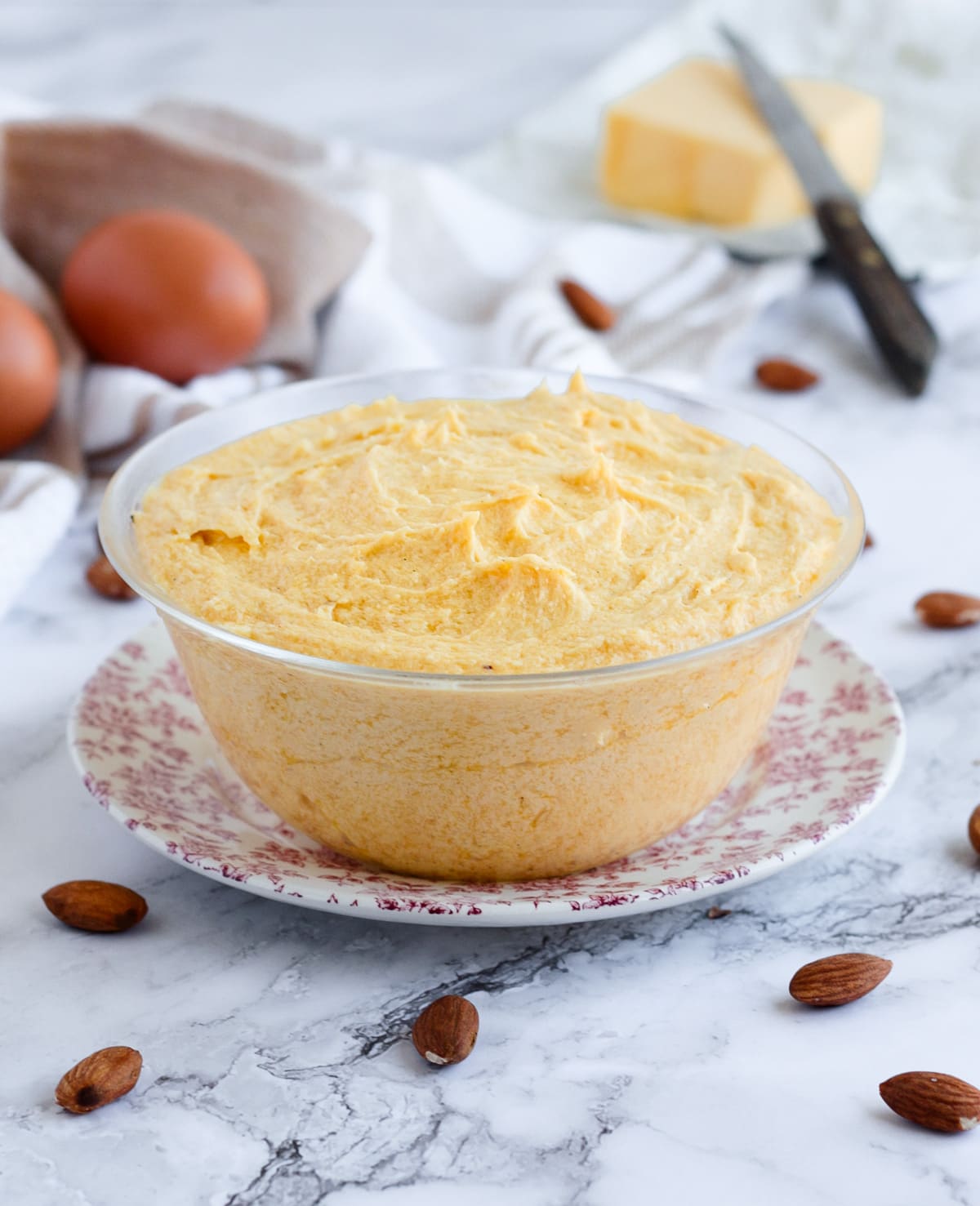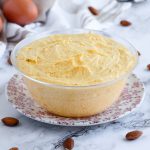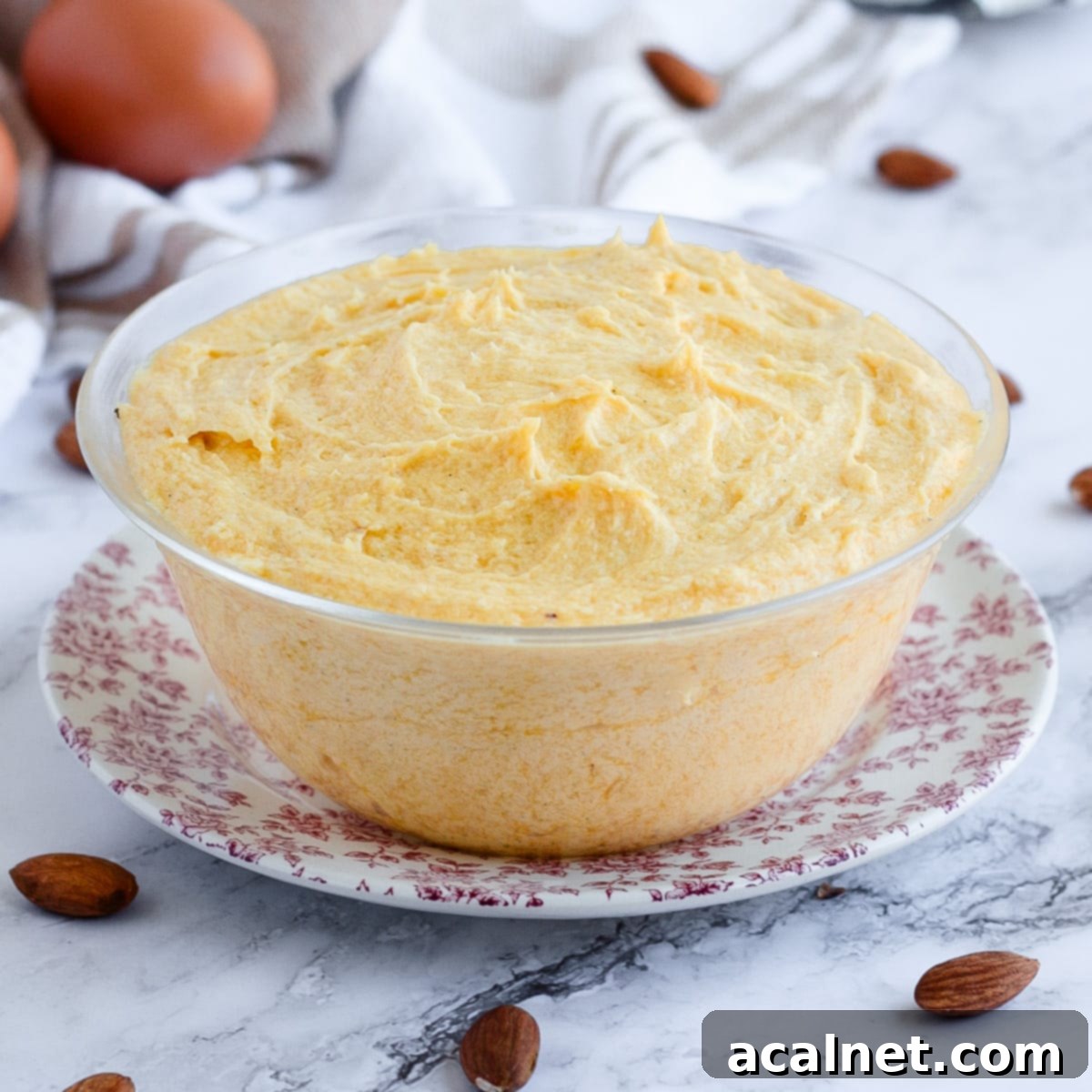The Ultimate 4-Ingredient Almond Cream Filling (Crème d’Amande) for Perfect Tarts & Pastries
Master the art of French pastry with this incredibly versatile and utterly delicious 4-ingredient Almond Cream Filling, often known as Crème d’Amande. This rich, nutty, and subtly sweet filling is your secret weapon for transforming ordinary tarts, cakes, pastries, and even croissants into extraordinary delights. Requiring just 10 minutes of active preparation, it’s a remarkably quick and simple recipe that delivers a sophisticated flavor and a delightfully light, almost sponge-like texture when baked. Whether you’re pairing it with vibrant fresh fruits or baking it into delicate pastries, this almond filling promises to elevate your baking journey.

Why You’ll Adore This Easy Almond Cream Recipe
This buttery, fragrant Almond Cream Filling is an indispensable tool in any baker’s repertoire, offering boundless possibilities for sweet creations. Imagine it baked to perfection within a rustic Pear Tart, transforming stale croissants into irresistible Almond Croissants, or adding a rich, moist layer to a special occasion cake. Its simplicity belies its incredible impact, making it a truly beloved recipe.
Beyond being super quick and easy to whip up, this recipe provides a foundational element of classic French Pastry, boasting extreme versatility. Made with just four core ingredients, it comes together effortlessly whether you’re using a stand mixer, a hand mixer, or even just a whisk and a bowl. When baked, the cream undergoes a delightful metamorphosis, puffing up to become incredibly light, airy, and beautifully golden – almost like a delicate almond sponge. Its texture is moist and tender, a perfect counterpoint to crisp pastry crusts.
The deeply flavourful almond notes in this cream pair exceptionally well with a wide array of fruits. It shines with the comforting tastes of Fall and Winter, as evidenced in delectable Apple Frangipane Tarts or elegant Pear Frangipane Tartlets. Yet, it’s equally sensational when combined with brighter Summer fruits, such as in a fragrant Peach Frangipane Tart. And for those moments when simplicity is key, it’s utterly delightful enjoyed plain within my classic Almond Tart!
What Exactly is a “Crème d’Amande“?
At its heart, Almond Cream, or “Crème d’Amande” in French, is a foundational almond-flavoured cream used extensively in French patisserie to fill tarts, pastries, and cakes. It’s renowned for its simplicity, being crafted from just four essential ingredients: Butter, Sugar, Eggs, and Ground Almonds (or Almond Meal).
The world of almond-based preparations can sometimes be a bit confusing, with terms like Almond Cream, Frangipane Cream, Almond Paste, and Marzipan often being used interchangeably. However, in classic French pastry, these terms denote distinct preparations, each with its unique composition and application. Understanding these differences is key to achieving authentic results:
- Almond Cream (Crème d’Amande): This is the simplest form, a rich, buttery mixture of softened butter, sugar, whole eggs, and ground almonds. It’s often baked, where it expands and takes on a cake-like texture. This is the star of our recipe today!
- Frangipane Cream: Technically, a true Frangipane is a more complex cream that combines Almond Cream (Crème d’Amande) with a basic Pastry Cream (Crème Pâtissière). This addition of pastry cream makes frangipane lighter, smoother, and more custard-like, often used in recipes like the traditional French Galette des Rois (King Cake). While many recipes colloquially refer to almond cream as frangipane, particularly outside of strict French patisserie, it’s important to recognize the subtle but significant difference.
- Almond Paste: This is a much denser, uncooked preparation typically made by grinding blanched almonds with powdered sugar and a small amount of egg whites (sometimes with almond extract). It’s very pliable and used for modeling or as a dense, chewy layer in pastries, distinct from a creamy filling.
- Marzipan: Similar to almond paste but generally finer in texture and higher in sugar content. It’s also made from ground almonds and sugar, often with rosewater or orange blossom water, and used predominantly for confectionery, molding, and covering cakes.
This recipe focuses on teaching you how to prepare the most fundamental – and easiest! – French Almond Cream, the pure and unadulterated “Crème d’Amande.”
The Essential Ingredients for Your Perfect Almond Cream

The beauty of this cream lies in its simplicity, requiring just four foundational ingredients, with the optional addition of vanilla or almond extract to enhance its flavour profile. Each plays a crucial role in achieving the desired texture and taste.
- Unsalted Butter: This should be very soft, ideally at room temperature. The quality of your butter significantly impacts the final flavour of your almond cream, so opt for a good quality brand if possible. Soft butter is essential for creaming properly with sugar, creating a light and airy base.
- Caster Sugar: Also known as fine white sugar, caster sugar dissolves easily, contributing to a smooth texture. While this recipe can work with icing or powdered sugar, the classic French method typically uses caster sugar for its slight granularity that aids in creaming and incorporating air.
- Whole Eggs: It is absolutely critical that your eggs are at room temperature. Furthermore, they should be at the same temperature as your softened butter to prevent the mixture from curdling (splitting) when combined. Precision is key here; for the best results, it’s highly recommended to weigh your eggs (without their shells) rather than relying on a count of “small” or “large” eggs, as their sizes can vary considerably.
- Almond Meal (Ground Almonds): Use blanched and skinned ground almonds. It’s important to sift your almond meal before use, as it tends to clump together when stored, which can lead to a lumpy cream. This recipe is also wonderfully adaptable – you can experiment with other nut flours, such as pistachio meal, as famously used in my Pistachio Tart, for a different flavour profile.
- Optional Flavouring: Consider adding Vanilla Paste (for a rich, aromatic sweetness) or a few drops of Almond Extract (for a more intense, sometimes slightly bitter, almond flavour). You can also introduce zest from a Lemon or Orange for a bright, citrusy twist. I personally prefer to stick to vanilla to let the natural almond flavour shine, but the choice is yours!
In its most traditional and perfect form, this almond cream adheres to a very simple yet effective 1:1:1:1 ratio. This means you use an equal quantity (by weight) of each of the four main ingredients: butter, sugar, eggs, and almond meal. This precise balance guarantees the ideal texture, richness, and baking performance. Always remember, the most accurate way to follow this ratio is to meticulously weigh all your ingredients, especially the eggs, for consistent and flawless results every time.

Step-by-Step Guide: Crafting Your Perfect Almond Cream Filling
Despite its elegant results, this recipe for Almond Cream is surprisingly straightforward to make. You have options for mixing: I typically use a Stand Mixer fitted with the paddle attachment for ultimate ease, but it can be just as successfully prepared with a hand mixer, or even entirely by hand if you prefer a more traditional approach. If mixing by hand, be prepared to whisk the butter and sugar for a longer period to achieve that crucial light and fluffy consistency.
Crucial Pre-Preparation Step: Before you begin, remember to remove both the butter and eggs (if refrigerated) from the fridge at least one hour in advance. This ensures the butter softens sufficiently and the eggs reach room temperature, both vital for a smooth, homogenous cream and to prevent the mixture from splitting.
- Step 1: Cream the Butter and Sugar (Photo 1 & 2): In the bowl of your mixer, combine the very soft room-temperature butter and the caster sugar. Beat them together on medium speed for about 3 to 5 minutes. The goal is to achieve a mixture that is light, airy, and noticeably paler in colour. This creaming process incorporates air, which is essential for the cream to puff up beautifully when baked. Scrape down the sides of the bowl occasionally to ensure even mixing.
- Step 2: Incorporate the Eggs (Photo 3 & 4): Add the room-temperature eggs, one at a time, mixing them in very slowly after each addition. For easier incorporation and to further prevent curdling, you can lightly beat the eggs in a separate bowl before slowly drizzling them into the butter-sugar mixture (*). Continue to mix until each egg is fully combined before adding the next.
- Optional Flavouring: If you’re using vanilla paste or almond extract, add it along with the last egg to ensure it’s evenly distributed throughout the cream.
- Step 3: Fold in the Almond Meal (Photo 5 & 6): Finally, add the sifted almond meal (remember to sift if it looks lumpy). Mix on a low speed, just until it is fully incorporated and the mixture is smooth. Be careful not to overmix at this stage, as overmixing can develop the gluten in the almonds, making the cream less tender.
- Step 4: Use or Store: Your delicious almond cream is now ready to use! It can be used immediately to fill your favourite tarts, pastries, or cakes. If preparing in advance, store it in an airtight bowl or container in the fridge, ensuring you cover the surface directly with plastic wrap to prevent a skin from forming and drying it out.
(*) Troubleshooting Tip: Don’t panic if your preparation appears to curdle or split slightly after adding the eggs. This can sometimes happen if the eggs or butter are a little too cold, or if the eggs are added too quickly, disrupting the emulsion. Rest assured, the mixture will miraculously come back together and smooth out beautifully once you add the almond meal. Just keep going!

Expert Tips for a Flawless Almond Cream
Achieving a perfect Almond Cream is simple when you follow a few key guidelines. These expert tips will help ensure your cream is smooth, flavourful, and bakes beautifully every time:
- Temperature is Key for Butter and Eggs: Always ensure both your butter and eggs are at room temperature. This is non-negotiable! Cold ingredients, particularly eggs, can cause the mixture to curdle or split, making it difficult to achieve a smooth emulsion. Plan ahead and take them out of the refrigerator at least an hour before you start baking.
- Creaming Time Matters: Don’t rush the creaming of the butter and sugar. Beat them together for a minimum of 3 to 5 minutes, or even longer if doing it by hand. The mixture should transform into a pale, fluffy, and airy consistency. This step is crucial because the air incorporated here is what will give the almond filling its signature light, puffy, and tender texture when baked.
- Weigh Your Eggs for Precision: For consistently perfect results, I cannot stress enough the importance of weighing your eggs (without their shells) rather than simply counting them. The size and weight of eggs can vary significantly, and using the exact amount ensures the right balance of moisture and richness in your cream.
- Don’t Fear the Curdle: If, despite your best efforts, the mixture curdles or appears to split after adding the eggs, don’t worry! This can happen if ingredients are slightly too cold or added too quickly. The good news is that the emulsion will typically come back together beautifully and smooth out once you incorporate the almond meal. Just keep mixing.
- Proper Storage Prevents Drying: If you’re preparing the cream in advance and storing it in the fridge, always cover it with plastic wrap pressed directly against the surface of the cream. This creates an airtight seal that prevents the top layer from drying out and forming a crust.
- Bring to Room Temperature Before Use (If Stored): If your almond cream has been chilling in the fridge for more than a few hours, remove it about an hour before you plan to use it. Allowing it to return to room temperature will soften the cream, making it much easier to spread evenly into your tarts, pastries, or cakes. A cold, stiff cream is harder to work with and might not bake as evenly.
Creative Ways to Use Your Delicious Almond Cream
This exquisite French Almond Cream is incredibly versatile and can be incorporated into a multitude of sweet recipes, transforming them into truly memorable desserts:
- Elegant Tarts: It’s the quintessential filling for classic tarts. Pair it with a crisp Sweet Shortcrust Pastry or a rich Chocolate Pastry. Top it with any of your favourite fruits to create stunning masterpieces like the classic French Bourdaloue Tart (Pear Frangipane), comforting Apple Frangipane Tart, vibrant Apricot Frangipane Tart, or any seasonal berries.
- Unique Dessert Combinations: Elevate your baking with creative fusions, such as making this incredible Honey Baklava Tart, where the almond cream adds a delightful richness.
- British Classics: It’s also the star of a classic British Bakewell Tart. Simply add a layer of your favourite jam at the bottom of a tart shell, then top with almond cream (just like my Almond Tart!) for an authentic taste.
- Delectable Pastries: The almond cream makes an irresistible filling for various pastries. Turn day-old croissants into divine Almond Croissants – yes, please! – or use it in puff pastry creations like turnovers, hand pies, or danishes for a flaky, nutty treat.
- Moist & Flavorful Cakes: Incorporate this cream as a delicious filling layer within your cakes, much like you would a custard cake. It adds a wonderful depth of flavour and a tender texture that complements many cake bases. You can also dollop it onto muffins or cupcakes before baking for a surprise almond centre.
- Fruit Gratins and Crumbles: Spread a layer of almond cream at the bottom of an oven-safe dish, top with sliced fruit (peaches, apples, berries work wonderfully), and bake until golden for a simple yet elegant dessert.

Frequently Asked Questions About Almond Cream
This is a common point of confusion, and while many recipes use “frangipane” and “almond cream” interchangeably, in classic French pastry, there’s a distinct difference:
- Almond Cream (Crème d’Amande): This is the simpler, foundational filling made solely from four ingredients: Butter, Sugar, Eggs, and Ground Almonds. It’s rich, dense, and bakes into a moist, cake-like texture. This is what you’re making with this recipe!
- Frangipane: Technically, frangipane is a composite cream. It is created by blending Almond Cream (Crème d’Amande) with a basic Pastry Cream (Crème Pâtissière). This addition lightens the texture and adds a subtle custard note, resulting in a creamier, often less dense filling. The true French style Frangipane (the one containing Pastry Cream) is most famously used in the traditional Galette Des Rois (King Cake). That being said, it’s true that many classic French and international pastry recipes will call for “Frangipane” when they are, in fact, referring to a simple Almond Cream. So, while technically different, they often refer to the same concept in broader culinary contexts.
No, Almond Cream Filling and Almond Paste are two distinct almond preparations with different textures, ingredients, and uses. Almond Cream (or Crème d’Amande), as we’ve discussed, is a creamy, buttery filling made with softened butter, sugar, whole eggs, and ground almonds. It’s intended to be baked and becomes light and custardy. Almond Paste, on the other hand, is a much denser, uncooked product. It’s made by finely grinding blanched whole almonds with powdered sugar and typically egg whites (sometimes with a touch of almond extract). It has a pliable, dough-like consistency and is often used for modeling, as a dense layer in certain pastries, or as an ingredient in other baked goods, but it is not a creamy filling in itself. Almond Paste is also frequently confused with Marzipan, which is similar but generally sweeter and even finer in texture, primarily used in confectionery.
Absolutely! While the classic 1:1:1:1 ratio is a perfect starting point and a benchmark for traditional Almond Cream, the sugar content can certainly be adjusted to suit your personal preference. I, for instance, often prefer my almond cream to be a little less sweet, allowing the natural nutty flavour of the almonds to shine through more prominently. I’ve successfully made this recipe using as little as half the sugar content specified without encountering any issues with the texture or baking performance. Feel free to experiment and reduce the sugar by 25-50% to find your ideal balance of sweetness. Just keep in mind that sugar also contributes to the moisture and browning of the cream, so very significant reductions might slightly alter these characteristics.
Proper storage is essential to maintain the freshness and safety of your almond cream:
- Immediate Use: If you plan to use the cream right after making it, there’s no need to chill or rest it. It can be used straight away to fill your tarts and pastries.
- Refrigeration: If you’ve made the cream in advance, it must be stored in the fridge. Because it contains raw eggs, it’s best consumed within two to three days. Always cover the cream with plastic wrap pressed directly onto its surface. This prevents a dry skin from forming and protects it from absorbing fridge odours.
- Freezing: Yes, almond cream can be frozen! Transfer it to a freezer-safe container or a heavy-duty freezer bag, ensuring it’s well-sealed. It can be stored in the freezer for up to 1-2 months. To use, thaw it overnight in the refrigerator. While freezing is a convenient option, for the absolute best texture and flavour, I always recommend making it fresh if possible. Once thawed, you might need to give it a quick whisk to bring back its smooth consistency before use.

Explore More Delicious Creams and Sweet Toppings
If you loved making this versatile almond cream, you might also enjoy experimenting with these other delightful creams and sweet pastry components to expand your baking repertoire:
- Chocolate Pastry Cream
- Vanilla Pastry Cream
- Whipped Chocolate Ganache
- Diplomat Cream (Crème Diplomate)
- Chocolate Cremeux
- Bavarian Cream (Crème Bavaroise)
- Namelaka (Velvety Chocolate Cream)
- Homemade Hazelnut Praline Paste
- Rich Pistachio Paste
Made this recipe?
We’d love to hear from you! Please let us know if you enjoyed it by leaving a comment below, and don’t forget to tag us on Instagram @a.baking.journey with a photo of your delicious creation!
Recipe Card: Easy Almond Cream Filling (Crème d’Amande)

Almond Cream Filling (Crème d’Amande)
Yields:
1 (approx. 600 grams or 2 1/3 cups)
Author:
Sylvie
10 minutes
0 minutes
10 minutes
Print Recipe
Prevent your screen from going dark
Ingredients
- 150 gr (2/3 cup) Unsalted Butter, very soft / room temperature
- 150 gr (2/3 cup) Caster Sugar, or fine white sugar
- 3 Small Eggs, or 150 gr of eggs without the shell, at room temperature
- 150 gr (1 1/2 cup) Almond Meal, sifted
- 1/2 teasp. Vanilla Paste or Almond Extract, optional
Instructions
- Place the very soft room temperature Unsalted Butter (see note 1 for temperature tips) and Caster Sugar into the bowl of your stand mixer. Using the paddle attachment, cream them together for 3 to 5 minutes on medium speed, until the mixture is light, fluffy, and visibly paler in color. This step incorporates essential air for a puffy baked texture.
- Add the room temperature Eggs, one at a time (see note 2 for details on egg incorporation and potential curdling). Mix slowly after each addition until fully incorporated. If using, add the Vanilla Paste or Almond Extract along with the last egg.
- Lastly, add the Almond Meal (ensuring it’s sifted if it tends to be lumpy) and mix on a low speed until it is just fully incorporated and the cream is smooth. Be careful not to overmix.
- Your homemade almond cream is now ready to use immediately for filling tarts, pastries, or cakes. Alternatively, it can be stored in the fridge for 2 to 3 days (covered with plastic wrap directly touching the surface to prevent drying out).
Video Tutorial
Would you like to save this recipe?
We’ll email this post to you, so you can come back to it later!
Notes
Ingredients Precision: For the most accurate and consistently perfect results, I strongly recommend weighing all ingredients using a kitchen scale rather than relying on cup and spoon measurements. This is especially vital for the eggs; weigh them (without their shells) to ensure you have exactly 150 grams, which typically equates to about 3 small eggs, as egg sizes can vary significantly.
- Butter Temperature: It is essential that your butter is very soft and at room temperature. Take it out of the fridge at least 1 hour (or even longer, depending on your ambient temperature) before you begin the recipe to ensure it creams properly and seamlessly with the sugar.
- Eggs at Room Temperature: Similarly, your eggs should be at room temperature. For easier incorporation and to prevent the mixture from splitting, I find it helpful to lightly beat the eggs together in a separate bowl before slowly adding them to the butter and sugar mixture. If the preparation does seem to split a little (curdle), do not worry; it will come back together and smooth out once you add the almond meal.
Nutrition (per serving)
